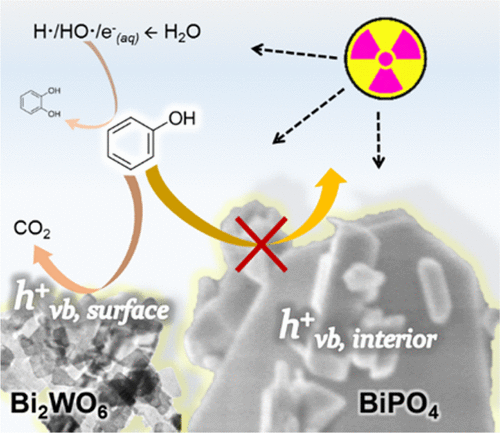当前位置:
X-MOL 学术
›
J. Phys. Chem. C
›
论文详情
Our official English website, www.x-mol.net, welcomes your
feedback! (Note: you will need to create a separate account there.)
X-ray Radiocatalytic Activity and Mechanisms of Bismuth Complex Oxides
The Journal of Physical Chemistry C ( IF 3.3 ) Pub Date : 2017-05-01 00:00:00 , DOI: 10.1021/acs.jpcc.7b00776 Sushant P. Sahu 1 , Ezra L. Cates 1
The Journal of Physical Chemistry C ( IF 3.3 ) Pub Date : 2017-05-01 00:00:00 , DOI: 10.1021/acs.jpcc.7b00776 Sushant P. Sahu 1 , Ezra L. Cates 1
Affiliation

|
Radiocatalysis is a process analogous to heterogeneous photocatalysis wherein activation occurs through absorption of ionizing radiation rather than visible or ultraviolet photons. Past studies have examined common metal oxide nanoparticles, yet the mechanistic and catalyst design differences between radio- and photocatalysis in aqueous suspensions are not fully understood. Herein, we report X-ray activity of highly attenuating bismuth complex oxides in driving degradation of phenol. Suspensions of Bi2WO6, BiPO4, and TiO2 (for comparison) showed highly disparate results under 205 kVp X-ray irradiation which did not correlate with established photocatalytic activities. Smaller catalyst particle size and two-dimensional morphology was found to be critical in discouraging the formation of unreactive interior electron–hole pairs during X-ray excitation, as revealed by luminescence measurements. Ultimately, Bi2WO6 was most effective at mineralizing phenol, showing the highest oxidative radiocatalytic mineralization rates reported to date. Scavenger studies also revealed a complex interplay between heterogeneous catalysis and reactive species produced by water radiolysis.
中文翻译:

铋复合氧化物的X射线辐射催化活性及其机理
放射催化是类似于非均相光催化的过程,其中活化是通过吸收电离辐射而不是可见光或紫外光子来发生的。过去的研究已经检查了常见的金属氧化物纳米粒子,但是对水悬浮液中放射催化和光催化之间的机理和催化剂设计的差异尚不完全清楚。在此,我们报道了高度衰减的铋复合氧化物在驱动苯酚降解中的X射线活性。Bi 2 WO 6,BiPO 4和TiO 2的悬浮液(作为比较)在205 kVp X射线辐照下显示出截然不同的结果,这与已建立的光催化活性无关。研究发现,较小的催化剂粒径和二维形态对于阻止X射线激发过程中不反应的内部电子-空穴对的形成至关重要,这通过发光测量可以看出。最终,Bi 2 WO 6在矿化苯酚方面最有效,显示了迄今为止报道的最高的氧化放射催化矿化速率。清道夫研究还揭示了非均相催化与水辐射分解产生的反应性物种之间的复杂相互作用。
更新日期:2017-05-06
中文翻译:

铋复合氧化物的X射线辐射催化活性及其机理
放射催化是类似于非均相光催化的过程,其中活化是通过吸收电离辐射而不是可见光或紫外光子来发生的。过去的研究已经检查了常见的金属氧化物纳米粒子,但是对水悬浮液中放射催化和光催化之间的机理和催化剂设计的差异尚不完全清楚。在此,我们报道了高度衰减的铋复合氧化物在驱动苯酚降解中的X射线活性。Bi 2 WO 6,BiPO 4和TiO 2的悬浮液(作为比较)在205 kVp X射线辐照下显示出截然不同的结果,这与已建立的光催化活性无关。研究发现,较小的催化剂粒径和二维形态对于阻止X射线激发过程中不反应的内部电子-空穴对的形成至关重要,这通过发光测量可以看出。最终,Bi 2 WO 6在矿化苯酚方面最有效,显示了迄今为止报道的最高的氧化放射催化矿化速率。清道夫研究还揭示了非均相催化与水辐射分解产生的反应性物种之间的复杂相互作用。


















































 京公网安备 11010802027423号
京公网安备 11010802027423号